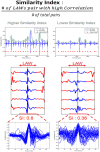Optimal substrate modification strategies using catheter ablation in patients with persistent atrial fibrillation: 3-year follow-up outcomes
- PMID: 33825268
- PMCID: PMC8252615
- DOI: 10.1111/jce.15033
Optimal substrate modification strategies using catheter ablation in patients with persistent atrial fibrillation: 3-year follow-up outcomes
Abstract
Objectives: This study aimed to assess the comparative efficacy of four ablation strategies on the incidence rates of freedom from atrial fibrillation (AF) or atrial tachycardia (AT) through a 3-year follow-up in patients with persistent AF.
Background: The optimal substrate modification strategies using catheter ablation for patients with persistent AF remain unclear.
Methods: Patients with persistent AF were enrolled consecutively to undergo each of four ablation strategies: (a) Group 1 (Gp 1, n = 69), pulmonary vein isolation (PVI) plus rotor ablation assisted by similarity index and phase mapping; (b) Gp 2 (n = 75), PVI plus linear ablations at the left atrium; (c) Gp 3 (n = 42), PVI plus the elimination of complex fractionated atrial electrograms; (d) Gp 4 (n = 67), PVI only. Potential confounders were adjusted via a multivariate survival parametric model.
Results: Baseline characteristics were similar across the four groups. At a follow-up period of 34.9 ± 38.6 months, patients in Gp 1 showed the highest rate of freedom from AF compared with the other three groups (p = .002), while patients in Gp 3 and 4 showed lower rates of freedom from AT than those of the other two groups (p = .006). Independent predictors of recurrence of AF were the ablation strategy (p = .002) and left atrial diameter (LAD) (p = .01).
Conclusion: In patients with persistent AF, a substrate modification strategy using rotor ablation assisted by similarity index and phase mapping provided a benefit for maintaining sinus rhythm compared with the other strategies. Both ablation strategy and baseline LAD predicted the 3-year outcomes of freedom from AT/AF.
Keywords: atrial tachycardia; persistent atrial fibrillation; phase map; pulmonary vein isolation; similarity index; substrate.
© 2021 The Authors. Journal of Cardiovascular Electrophysiology Published by Wiley Periodicals LLC.
Figures




Similar articles
-
Stand-Alone Pulmonary Vein Isolation Versus Pulmonary Vein Isolation With Additional Substrate Modification as Index Ablation Procedures in Patients With Persistent and Long-Standing Persistent Atrial Fibrillation: The Randomized Alster-Lost-AF Trial (Ablation at St. Georg Hospital for Long-Standing Persistent Atrial Fibrillation).Circ Arrhythm Electrophysiol. 2017 Jul;10(7):e005114. doi: 10.1161/CIRCEP.117.005114. Circ Arrhythm Electrophysiol. 2017. PMID: 28687670 Clinical Trial.
-
Ganglionated plexus ablation vs linear ablation in patients undergoing pulmonary vein isolation for persistent/long-standing persistent atrial fibrillation: a randomized comparison.Heart Rhythm. 2013 Sep;10(9):1280-6. doi: 10.1016/j.hrthm.2013.04.016. Epub 2013 Apr 19. Heart Rhythm. 2013. PMID: 23608592 Clinical Trial.
-
Ablation of Complex Fractionated Electrograms With or Without ADditional LINEar Lesions for Persistent Atrial Fibrillation (The ADLINE Trial).J Cardiovasc Electrophysiol. 2017 Jun;28(6):636-641. doi: 10.1111/jce.13206. Epub 2017 Apr 21. J Cardiovasc Electrophysiol. 2017. PMID: 28316148 Clinical Trial.
-
Efficacy of cardiac autonomic denervation for atrial fibrillation: a meta-analysis.J Cardiovasc Electrophysiol. 2012 Jun;23(6):592-600. doi: 10.1111/j.1540-8167.2011.02270.x. Epub 2012 Mar 19. J Cardiovasc Electrophysiol. 2012. PMID: 22429251 Review.
-
Catheter Ablation of Paroxysmal Atrial Fibrillation: Have We Achieved Cure with Pulmonary Vein Isolation?Methodist Debakey Cardiovasc J. 2015 Apr-Jun;11(2):71-5. doi: 10.14797/mdcj-11-2-71. Methodist Debakey Cardiovasc J. 2015. PMID: 26306122 Free PMC article. Review.
Cited by
-
Atrial fibrillation activation patterns predict freedom from arrhythmias after catheter ablation: utility of ExTRa mapping™.Front Cardiovasc Med. 2023 Jul 28;10:1161691. doi: 10.3389/fcvm.2023.1161691. eCollection 2023. Front Cardiovasc Med. 2023. PMID: 37576113 Free PMC article.
-
Percutaneous Treatment Approaches in Atrial Fibrillation: Current Landscape and Future Perspectives.Biomedicines. 2022 Sep 13;10(9):2268. doi: 10.3390/biomedicines10092268. Biomedicines. 2022. PMID: 36140368 Free PMC article. Review.
-
Optimal mitral isthmus flutter ablation by radiofrequency.J Interv Card Electrophysiol. 2024 May 25. doi: 10.1007/s10840-024-01818-7. Online ahead of print. J Interv Card Electrophysiol. 2024. PMID: 38789650 No abstract available.
-
Tailored bi-atrial linear ablation guided by electrophysiological mapping for persistent atrial fibrillation.BMC Cardiovasc Disord. 2024 Nov 20;24(1):658. doi: 10.1186/s12872-024-04332-w. BMC Cardiovasc Disord. 2024. PMID: 39567904 Free PMC article.
References
-
- Wyse DG. A critical perspective on the role of catheter ablation in management of atrial fibrillation. Can J Cardiol. 2013;29:1150‐1157. - PubMed
-
- Verma A, Jiang C, Betts TR, et al. Approaches to catheter ablation for persistent atrial fibrillation. N Engl J Med. 2015;372:1812‐1822. - PubMed
-
- Verma A. The techniques for catheter ablation of paroxysmal and persistent atrial fibrillation: a systematic review. Curr Opin Cardiol. 2011;26:17‐24. - PubMed
-
- Jaïs P, Hocini M, Hsu L‐F, et al. Technique and results of linear ablation at the mitral isthmus. Circulation. 2004;110:2996‐3002. - PubMed
-
- Nademanee K, McKenzie J, Kosar E, et al. A new approach for catheter ablation of atrial fibrillation: mapping of the electrophysiologic substrate. J Am Coll Cardiol. 2004;43:2044‐2053. - PubMed
Publication types
MeSH terms
LinkOut - more resources
Full Text Sources
Other Literature Sources
Medical

